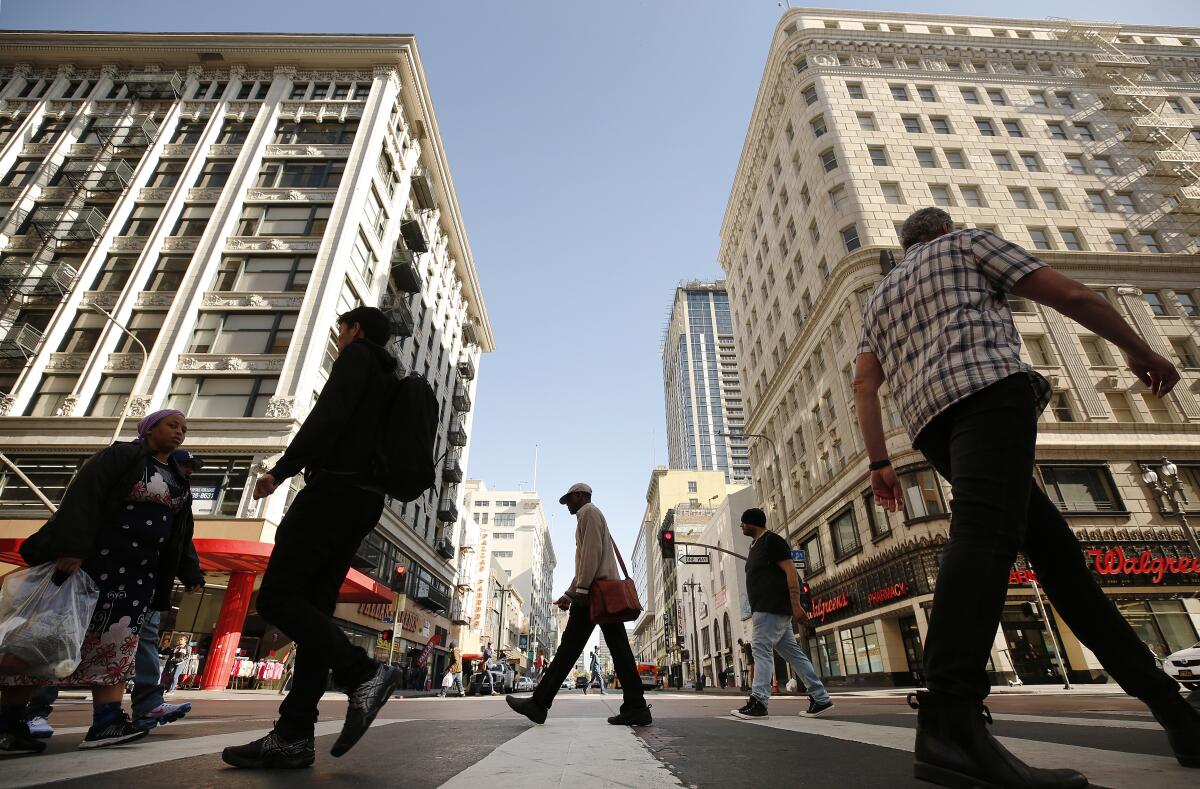Should cars be banned on Broadway in downtown L.A.?

Banning cars from downtown streets is beginning to catch on in major U.S. cities, with New York and San Francisco moving to free up space for transit vehicles, pedestrians and cyclists.
But the trend hasn’t come to Los Angeles — yet.
A proposal introduced by Los Angeles Councilman Jose Huizar could change that. The councilman asked city officials last week to study the feasibility of a ban on driving and parking along a 1.5-mile stretch of Broadway between 1st and 12th streets.
Broadway is “an ideal street to go car-free,” Huizar said, because narrower roadways and expanded space for pedestrians have already begun to transform the iconic corridor. Eliminating private cars could make the street safer and more efficient for a streetcar that the city plans to build, officials said.
If approved, the ban would be the biggest transportation change along Broadway since the region’s streetcars were ripped out after World War II and the Metro subway opened in 1993.
Broadway would be the first major street in Los Angeles to go car free. Last month, Councilman Mitch O’Farrell’s office proposed a dramatic overhaul of Hollywood Boulevard along the Walk of Fame that could include far less space for private cars.
Business owners, residents and tourists along Broadway said the proposal intrigued them but was short on details. To succeed, they said, the car ban would need buy-in from residents, theater operators, hotels, restaurateurs and small businesses trying to hang on as rents rise.
“Some ideas are great and can still have unintended consequences,” said Blair Besten, the executive director of the Historic Core business improvement district, who said she was intrigued by the proposal. “We will need to reflect on how it will impact a major urban center.”
The study will include an analysis of how the city could ensure access to residential parking garages and commercial loading zones for bars, restaurants and retail stores.
Numbered cross streets would not be closed to traffic at Broadway, so cars, trucks and other vehicles could still cross Broadway at intersections with traffic signals, Huizar’s motion said. Fire trucks, police cars and buses would still be allowed.
It will take time to collect feedback from city departments and from the community, so “it is premature at this point to offer a specific timetable, what the final recommendations will be or what is expected to be the final cost,” Huizar spokeswoman Laura McKinney said in an email.
Huizar, first elected to the City Council in 2005, must step down in November because of term limits. He hopes that his successor “will take up the baton after his term ends,” McKinney said.
Broadway was the heart of pre-World War II Los Angeles, and later became the region’s premier shopping destination for Latino families before falling into disrepair at the end of the 20th century.
If the changes were approved, city planners face the challenge of redesigning a street long oriented toward the automobile, while still retaining the energy that families remember, said James Rojas, an urban planner who worked at the May Co. department store on Broadway in high school.
“Broadway is part of the cultural DNA for people whose families have been here for generations,” Rojas said. “You have to find a way to make this major change and still keep the vibrancy, the interest, the activity.”
Some workers spilling out into the sunshine for their lunch hour said they feared that a car ban on Broadway, one of downtown’s few two-way streets, could send traffic spilling onto parallel routes, like Main and Spring streets. Car lanes there have been reduced to make space for protected bike lanes.
“Traffic is already really bad,” said Jorge Rivera of Montebello as he and two other construction workers split a tray of sopes at a sidewalk table near the Orpheum Theatre. The changes could be nice for tourists, he said, but many workers who need trucks and tools “can’t just stop driving.”
Broadway is one of the busiest downtown streets for pedestrians, which means good business at lunchtime, said Cristy Alvarez. The food truck operator did a brisk business selling hot dogs, Fritos and soda to office workers and sweaty tourists near the Globe Theatre.
Alvarez said she had watched with alarm as mom-and-pop businesses at the Grand Central Market closed down. Many were replaced by their pricier, hipster counterparts: Cold-pressed juice instead of aguas frescas; hand-scooped $1 ice cream edged out by a Santa Barbara creamery.
Perhaps, she said, the city could carve out space for a few loncheras in the pedestrian-only zone. Food trucks, she said, are “here to make food, not traffic.”
Outside the Grand Central Market, tourist Anna Roy said Denver has seen that a pedestrianized street can be a success. The 16th Street Mall, which allows buses and pedestrians, has streets and sidewalks designed by I. M. Pei and has been closed to car traffic since 1982.
Roy and her boyfriend had taken a “very hairy” scooter ride from their Airbnb in South Park that morning, unsure whether the sidewalk or the street was safer, she said.
“It would be a lot more relaxing if cars weren’t part of the equation,” said Roy, 32, as she ate a coddled egg on toast from the breakfast restaurant Eggslut. And, she said, as drivers honked in the background, it would be quieter.
On a sell-out night at the historic Orpheum a decade ago, the parking lots nearby would be full, said Steve Needleman of Anjac Fashion Buildings, a real estate firm that owns the theater, as well as office space, residential buildings and parking lots downtown.
Today, at least half of the audience arrives by Uber, Lyft or subway, Needleman said. That change in consumer habits, plus the surge of people walking and shopping at night, opened his mind to the idea of closing Broadway to cars after years of being “adamantly against it,” he said.
The plan has downsides, Needleman said, including the possibility of parking lot operators losing business. “But looking at what is best for Broadway, we have to give it a shot,” he said.
Needleman is also the chairman of Los Angeles Streetcar Inc., the nonprofit that plans to build a trolley line between the Civic Center and the Staples Center.
Earlier plans for the streetcar did not include a separate lane, meaning the vehicles would have been at the mercy of traffic congestion, accidents and idling vehicles. The average estimated speed was 6 mph. Without private cars, the line would operate more efficiently, Needleman said.
The streetcar is slated to receive $200 million through the sales tax Measure M in 2053. The city “is in discussions with Metro to expedite this funding,” McKinney said, and Needleman said Los Angeles Streetcar Inc. is pursuing a private partnership and a federal grant to build the project more quickly.
More to Read
Sign up for Essential California
The most important California stories and recommendations in your inbox every morning.
You may occasionally receive promotional content from the Los Angeles Times.










